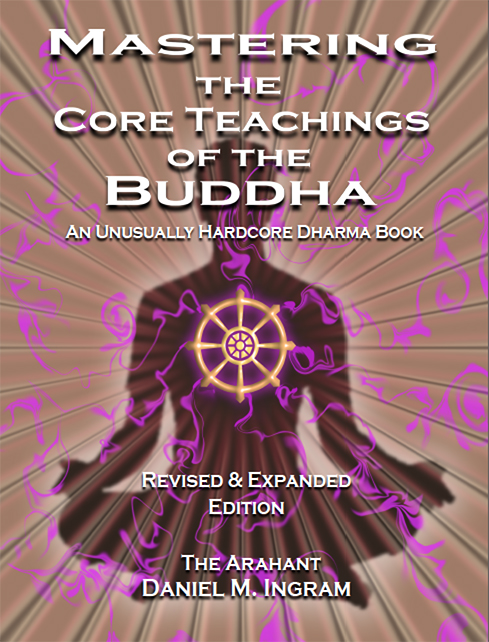The Psychological Models
← The Specific Knowledge Models | The No-Thought Models →
Here is another thing that didn’t happen upon awakening: psychological perfection. While the mainstream Western Buddhist world is absolutely drowning in the notion that somehow Buddhist practice will either eliminate all their psychological “stuff”, or at least cause them to become self-actualized in the good old psychoanalytical sense, nothing could be further from the truth except totally bogus models such as the Action models. I think that I learned more about reasonable psychological health from reading one book on transactional analysis (Ian Stewart and Vann Joines’ fascinating book TA Today: A New Introduction to Transactional Analysis) than I did from over a decade of highly successful Buddhist meditation. That doesn’t mean that I have achieved perfect psychological health, not by a long shot!
Focusing almost exclusively on psychological growth over insight practice is an epidemic disease in Western Buddhism. Many of the major retreat centers that purport to foster insight practice in the US and Europe are really bastions of the worst pop psychological bullshit retrofitted with a bastardized Buddhist front. You have only to go to a few small group meetings on retreats, as I mentioned in Part Two, to hear that the majority of people who are supposed to be doing insight practices are actually just wallowing in their own neurotic crap. Sure, they may be highly intelligent, super sophisticated, fantastically well-rationalized, pseudo-Buddhist practitioners of the Great Sacred Neurotic Crap Wallow, but they are wallowing just the same.
While the dharma is vast, and the teachings of the wisdom traditions contain a lot of material for helping us grow psychologically, we can’t conflate psychological growth and maturity with awakening, and letting people get stuck in the Great Dismal Crap Quagmire does them little service, if you ask me, which you clearly did, as you are reading this book. As I said before, working on our psychological stuff can have lots of value, and Western psychology has added a vast array of useful conceptual frameworks and techniques to the world of psychological health and human development, but I firmly believe that clearly drawing the line between insight practice and psychological work is essential to doing either well. I have been to therapy and really got a lot out of it, just on a totally different front from what insight practices got me. It is not that I haven’t had psychological insights of great value when on retreat, as I have had plenty, but those psychological insights came from good insight practice as some surprising and appreciated side effect rather than the other way around.
Further, it is oh-so-easy to imagine that the teachers on the front cushions couldn’t possibly be as neurotic as we are, and before you know it we have the breeding ground for massive shadow sides, exploitation, isolation, and scandal, just like we had with the models that serve up emotional perfection. The jet-set culture of teachers popping in and out of town, getting up on the front cushion, spouting their beautiful ideals, and jetting off to somewhere else before anyone can see them as the humans they really are, only goes to reinforce these dangerous notions. It is just so easy to project all kinds of wondrous qualities onto them when the dream is so nicely laid out, the opportunities for reality testing so few, and the amount of transference and countertransference out there is simply huge.
As an aside of great importance: anyone working with meditation teachers or teaching meditation should read up on projection, transference, and countertransference, as these fly thick and fast in the world of meditation just as they do in psychology (and basically all other human interactions). Want to perform a not-so-fun experiment that teaches you hard lessons about what ordinary adults can do and say when they get caught up in projection and transference? Write a book called something like Mastering the Core Teachings of the Buddha, call yourself something such as an arahant, and watch the projection and transference fly despite your best attempts to bring things back to earth in that very book. Ah, good times …
Other highly recommended topics of useful theory that Western psychology provides that are largely lacking in Buddhism: narcissism, narcissistic injury, narcissistic rage, and narcissistic supply. All of these are worth reading up on and recognizing when they occur. While knowledge of them is not enough to eliminate their negative effects, it is better to understand the mechanisms than not. It is true that skillful use of transference can occasionally occur, but that is as slippery a slope as they get. Clearly, the amount of transference, projection, and idealization suits most teachers just fine, or they would go more out of their way to counter those notions and set the record straight, but, as those teachers quickly learn, countering those notions just doesn’t sell well most of the time, and getting caught up in that sort of transference feels mighty friggin’ nice.
Thus, I think that models that reinforce the notion that psychological perfection or freedom from our psychological stuff will come simply by seeing through the sense of a separate, permanent agent are a serious problem for these major reasons:
1) they simply aren’t true;
2) they cause practitioners to get caught up in their stuff rather than focusing on the three characteristics or something functionally equivalent, thus squandering the majority of practitioners’ limited retreat and practice time;
3) they allow teachers to be able to ride the hot air of preposterous ideals to dangerous heights, as meditation scandal sheets reveal again and again;
4) they contribute to the erroneous sense of the gap between this ordinary, human existence and awakening by creating unrealistic ideals and goals.
Most Buddhist practitioners whom I know have something like one or more of the following belief structures:
1) awakening is impossible, so the best thing to try for is psychological or emotional health or perfection;
2) awakening is equivalent to psychological or emotional perfection, so by trying for psychological or emotional perfection we are doing the practices that lead to awakening;
3) awakening involves psychological or emotional perfection, so it clearly is impossible, and by sitting we are trying to accomplish something else, but if you ask them what that goal is they are usually unable to answer clearly.
What is so ironic is that awakening is hard but clearly not impossible, and not nearly as impossible as achieving psychological or emotional perfection. In fact, seeing sensations clearly enough to see that they are all just happening—coming and going—is extremely straightforward once you finally realize that this is what you are supposed to be doing. Further, when I think back on all the things I have done, including going to medical school, working as a volunteer for a year in India, and finishing an emergency medicine residency, I must say that what I went through to get those things was significantly more work than it took to get to stream entry and even arahantship.
It is not that getting stream entry was easy, just not as hard as plenty of other things I have done. I attribute my success to a vast array of factors, but two that are relevant here are a tolerance for pain and having a good working model that I was willing to modify as data from the experiment swamped prior hypotheses. That model was one that was blissfully free of the notion of emotional or psychological perfection. Psychological growth and maturation are reasonable things to aspire to and cultivate, but exaggeratedly high ideals involving notions of perfection are damaging and toxic to most practitioners, as reality testing has shown again and again.
When I think about what it would take to achieve freedom from all psychological stuff, the response that comes is this: life is about stuff. Stuff is part of being alive. There is no way out of this while you are still living. There will be confusion, pain, miscommunication, misinterpretation, maladaptive patterns of behavior, unhelpful emotional reactions, weird personality traits, neuroses, and possibly much worse. There will be power plays, twisted psychological games, people with major personality disorders (which may include ourselves and our dharma friends and teachers), and craziness. The injuries continue right along with the healing and eventually the injuries win and we die. This is a fundamental teaching of the Buddha (SN 4.6). We could arguably classify all of these as learning and growth opportunities, or we could lump them into the great slagheap called “suffering”; you must determine for yourself which paradigm works best for you as you go along. I wish the whole Western Buddhist world would just get over this notion that these practices are all about getting to our happy place where nothing can ever go wrong, hurt us, or make us neurotic, and move on to mastering real Buddhist practice rather than chasing some ideal that will never appear.
All that said, there is some debate about what factors or progress allow some people to just notice the three characteristics of the sensations that make up their world in the face of their stuff as opposed to those who just flounder in their stuff. This question applies to many of skillful meditative practices. Some would argue that you must have done enough psychological work and have dealt with enough of your issues or grown up in a sufficiently healthy psychological context to get to the place where you can move on to the next stage. I must reluctantly admit that there is probably some truth to this for many people. However, I did not consider myself particularly psychologically advanced, mature, or evolved when I started insight practices, nor did anyone who knew me well. I had all kinds of stuff to deal with and still do. Despite this, through good instruction, complete faith in the straightforwardness of the technique, and perhaps some other factors I have yet to identify, I was able to practice well despite everything and make the shift from being lost in content to noticing how things are.
A subset of the psychological models is the specific issues model, which says that we must completely work out each of our issues along the way and that progress is essentially a countdown to having no issues at all, whatever that means. It is true that attaining a sufficiently wise and functional perspective on some issues can facilitate having a better life and also mastering insight practices. It is also true that insight practices can sometimes shed valuable light onto and improve our perspective on specific issues as we go along.
However, I do not accept the notion that we simply eliminate some personal numbered master list of our issues (as understood in the standard pop-psychological sense) one by one and when we are done that is it. That model places the focus so totally in the realm of content that it is hard to imagine anyone really understanding the direct clarity that comes from insight practices if they are working with that sort of a model. I have yet to meet anyone who could possibly be said to be anything resembling “issue-free” no matter how much successful practice they have done. I find no Buddhist texts that even promise anything like the idea of being “issue-free”, as these sorts of concepts and ideals didn’t seem to exist then; this issue model has seemingly arisen out of the last century or so of the development of modern psychological theory in the West.

